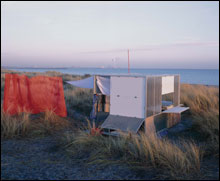 Like countless others, when I was a student and moving each year from dorm to apartment and then to another apartment, I made bookshelves out of bricks and planks of wood. These bookshelves represented simple yet flexible, low-maintenance contemporary domestic furnishing. Not only were they functional, they were also cost-effective and could easily expand or contract. I loved them. There is a human universality to dealing with and “owning” our environment.
Like countless others, when I was a student and moving each year from dorm to apartment and then to another apartment, I made bookshelves out of bricks and planks of wood. These bookshelves represented simple yet flexible, low-maintenance contemporary domestic furnishing. Not only were they functional, they were also cost-effective and could easily expand or contract. I loved them. There is a human universality to dealing with and “owning” our environment.
American Olympic “maverick” skier Bode Miller grew up in an isolated New Hampshire log cabin without running water or electricity. This is an unusual circumstance that makes for good press, but it’s also a notable example of people living in a more adaptive environment. I knew an artist who lived in a yurt in the woods outside Portland, Maine. He seemed quite normal in conversation, dress, and even sense of humor. He was of the age that came to adulthood in the ’60s and ’70s and morphed, flexibly or painfully, from middle-class buttoned-up America to post-hippie lifestyles and careers. His decision to live in an adaptive, minimalist, alternative space was, like that of Bode Miller’s parents (also former hippies), an outgrowth of his times, culture, and education.

Architecture and design are art forms that we all live with each day. They seem less esoteric than the fine arts; perhaps that’s why everyone seems to have an opinion on our built environment. And why new construction, new object forms, and even related exhibitions can elicit such visceral reactions. The most creatively and universally designed objects often add materially to our enrichment, comfort, and exuberance. Just consider the iPod.
This sense of designer joy is palpable in the Institute of Contemporary Art’s “Living in Motion: Design and Architecture for Flexible Dwelling,” an exhibition that, organized by the Vitra Design Museum in Weil am Rhein, showcases a range of clever, often elegant furniture and sometimes beautiful furnishings and objects. Tracing flexible modes of living through centuries of design creativity, this show stretches across cultures and continents. The pieces underscore the history and tradition of the flexible, multi-functional well-designed and sometimes wonderful pieces of our contemporary domestic life.
“Living in Motion” includes the usual suspects — Charles and Roy Eames, Philippe Starck, Alvar Aalto, Joe Colombo, Buckminster Fuller — but also many lesser-known designers and design examples. Encompassing a wide variety of mostly domestic objects and furnishings, primarily contemporary or modern but sometimes historical, the show is divided into six thoughtfully themed sections: “Transporting,” “Assembling and Disassembling,” “Folding and Unfolding,” “Adapting,” “Combining,” and “Wearing and Carrying.”
The objects in “Assembling and Disassembling” demonstrate the many ways in which elements can connect and disconnect, expand and contract, open and close. Modern classics including nesting tables by Marcel Breuer (1936), stacking stools by Alvar Aalto (1932), a temporary dwelling of prefabricated parts for refugees by Jean Prouvé (1939), and a furniture system (1940) for a design competition at the Museum of Modern Art, “Organic Design in Home Furnishings,” by Charles Eames and Eero Saarinen. An example of my friend’s yurt and Wes Jones’s “Pro/Con Package Housing System” (2000), which employs containers as interchangeable mobile housing units or offices/warehouses, attest to the breath of the show. The disassembling of objects also serves the functional purpose of easier transportation.
“Folding and Unfolding” refers to the space-saving and organizing ways in which objects can expand and contract. Folding and unfolding also facilitates the transportation of people and objects. Folding and unfolding can divide or open up rooms and spaces. The examples here include various and sometimes spatially as well as materially elegant collapsible chairs, Asian ethnic floor mats, a folding Eames screen and a fabulous Cupboard Bath (1970) by TUR, a German manufacturer, that’s built in a kitchen cupboard typical of old workers’ housing in the Ruhr area of Germany.
The “Transporting” group includes Mathieu Mategot’s tea wagon (1950), an Eileen Grey side table with carrying grip (1927), and Joe Colombo’s Mini Kitchen (1963), a minimalist unit that includes a refrigerator, burners, workspace, and storage on castors. Transporting is not limited to furniture on wheels; it looks also at portable vessels and elements on the water.
“Adapting” — objects that can adjust to changing physical needs — includes Joe Colombo’s “Multichair” (1970), which is created from two cushions and two leather straps that combine to allow varying seat and lounge options. The ancient hammock design originated in South America, where people still use it for sitting and lying. “Combining” integrates two or more functions into a single object — a sofa bed, for example. Or the stool, side table, and tray by Max Bill and Hans Gugelot (1954). Verner Panton’s minimalist sculpture Phantom (1998) morphs easily into a chair in many different positions and a table. A spectacularly elegant Rocker/Pedestal (1942) created by Frederick Kiesler for Peggy Guggenheim’s Art of the Century Gallery acted as comfortable seating and display space.